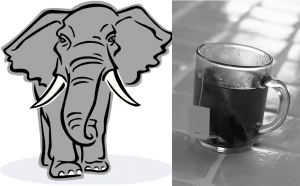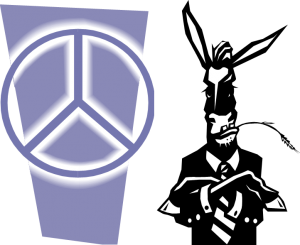11/9/2010 (These notes are in response to a number of inquiries and hardly represent a fully thought out strategic view. I invite your comments: bobwing68@gmail.com.)
This election highlights the extraordinarily high stakes of this period in U.S. and world history, and is a barometer of which way the country is moving. As I see it the Republicans scored a remarkable victory at a critical juncture in a historic struggle marked by two huge trends.
1. Although the U.S. is still clearly the most powerful country in the world politically, economically and militarily, the clear trend over the last 60 years and especially the last few decades is that Western domination of the world is eroding and the rest of the world is rising. In the last few decades the U.S. has been losing its position as the world’s only superpower and non-Western countries, led by the BRIC (Brazil, Russia, India, China), are quickly growing in power. For example, the G-8 has been supplanted by the G-20; many countries now ignore the WTO and the IMF; regional economic blocs are becoming more powerful and are linking to each other without going through the West; and the U.S. could not build a broad coalition behind its war on Iraq.
 The country and the world are in a particularly aggravated period of that transition marked by a battle over whether or not to accept the loss of superpower status, how to navigate it when the U.S. is still the strongest country in the world, and indeed whether to fight to retain superpower status by extreme violent and aggressive means (the Bush II line). This debate is particularly sharp now due to the economic crisis which focuses the issue of the decline of the U.S. The environmental/climate crisis is also part of this discussion. How quickly or slowly will be the decline of the U.S. How rapid will the developing countries led by the BRIC countries move forward and what economic and political forms will they take? How violent will the process be? What new role or roles will the U.S. assume, and what other countries will gain power? How will the U.S. economy, government and military be reshaped to meet these challenges?
The country and the world are in a particularly aggravated period of that transition marked by a battle over whether or not to accept the loss of superpower status, how to navigate it when the U.S. is still the strongest country in the world, and indeed whether to fight to retain superpower status by extreme violent and aggressive means (the Bush II line). This debate is particularly sharp now due to the economic crisis which focuses the issue of the decline of the U.S. The environmental/climate crisis is also part of this discussion. How quickly or slowly will be the decline of the U.S. How rapid will the developing countries led by the BRIC countries move forward and what economic and political forms will they take? How violent will the process be? What new role or roles will the U.S. assume, and what other countries will gain power? How will the U.S. economy, government and military be reshaped to meet these challenges?
 2. White domination of the U.S. is eroding as peoples of color and their allies within the U.S. are gaining more power, economically and politically, and as their numbers grow state by state and in the nation as a whole. The clock is ticking on when peoples of color will become the majority of the country driven by immigration and higher birth rates. Again we are at aggravated transition symbolized by the election of a black president that many perceive has moved the clock up on this process by decades as well as high immigration levels. How peaceful or violent will that process be (armed militias are growing at an alarming pace)? How short or long? How skillful will the adversaries in this process be?
2. White domination of the U.S. is eroding as peoples of color and their allies within the U.S. are gaining more power, economically and politically, and as their numbers grow state by state and in the nation as a whole. The clock is ticking on when peoples of color will become the majority of the country driven by immigration and higher birth rates. Again we are at aggravated transition symbolized by the election of a black president that many perceive has moved the clock up on this process by decades as well as high immigration levels. How peaceful or violent will that process be (armed militias are growing at an alarming pace)? How short or long? How skillful will the adversaries in this process be?
In the world of U.S. politics these two huge trends combine: increasingly the axis of U.S. politics is how to deal with the growing power of people of color at home and abroad and the decline of white American privilege and power at home and abroad. The Republican Party, especially its powerful far right, fairly consistently represents the reactionary position. The Democratic Party, mainly the leftwing of it, haltingly and unevenly represents the other. The center is an increasingly volatile and active majority and wildly vacillates. It is this historical clash that shaped the 2010 election perhaps more clearly than any before it. Without a doubt the Republicans and the far right won a big victory in 2010.
Since 1964 (Goldwater) and especially since 1980 (Reagan) the Republican Party has increasingly become the party of aggressive imperialism and aggressive racist backlash. It has dominated U.S. politics, especially the presidency, since 1968, not only reversing the historic civil rights movement but cutting away at the welfare state, adopting a more aggressive foreign economic and military posture and shifting U.S. politics far to the right. In today’s political spectrum the policies pursued by Richard Nixon might make him a liberal Democrat.
Over that period the traditional pragmatic center-right of the Republican Party has been losing power to its ideological and hardcore racist right wing based in the white South, Southwest and Rocky Mountain states. The Tea Party movement is the latest incarnation of the far right, this time with an urgency that stems from the two trends above, spiked even more by the economic crisis that has stoked fears about those processes even more, and symbolized by the election of a black president and the rise of immigration. They feel they are “losing their country” to people of color and their allies and to China and other uppity Un-American countries. Forty percent of voters this year said they backed the Tea Party, including 47 percent of people over 65.
While the Tea Party got most of the headlines, the main factions of the ruling class, feeling burned by health care and financial reform and feeling emboldened after having been bailed out, clearly swung back to support the Republicans in this election after having largely backed Obama and the Democrats in 2008 and was willing to unite with the reactionary Tea Party to ensure a Republican victory. Their clout was even greater than usual after the Supreme Court cleared the way for unlimited corporate campaign contributions. Whether they will resume their brief flirtation with Keynesianism and a managed move away from their superpower status or whether they will opt for reestablishing their supremacy through domestic social austerity and foreign aggression is a huge question. If they do the latter, the attack on government workers and poor folks may be withering and foreign affairs will be fraught with the danger of shooting and trade wars.
The victory of the Republicans, spearheaded by the Tea Partyists and the main sectors of big capital, signals that they have reorganized and reseized the initiative in a major way.
After forty years of Republican ascendance and eight years of a uniquely disastrous Bush presidency including historic military, diplomatic and economic failures, in 2008 Obama finally galvanized the center left to victory. The main sectors of big capital and most of the center tilted Democratic in 2008. However, without a dynamic or strong force to his left that could seize the initiative for a people’s response to the economic crisis, Obama got stuck in the vacillating center and was over the last two years got isolated.
The forces to the left of Obama, the strongest of which is by far the labor movement, failed to seize the opportunity provided by the economic crisis to galvanize the country in a people’s opposition to the economic crisis, thereby providing a vacuum that the Republicans, both ruling class forces and reactionary populist Tea Partyists, seized. The black/brown vote saved the Democrats in California and in a few other races in the Southwest, but the Democrats suffered one of the largest mid-term setbacks ever at the federal, state and local levels. This defeat will reverberate for many years as the Republicans are positioned to try to institutionalize many of their gains in the Redistricting battles that loom in the next year.
Since the 1990s, marked by the Reform Party of Ross Perot, the center of U.S. politics has become active and dynamic, and more politically defined around pragmatic, non-ideological, non-partisan fiscal conservatism. It is no longer the “silent majority” that it usually is. It is important to note that the most successful third party in U.S. history, the Reform Party, came not from the left or right of U.S. politics, but from the center. The Party won 20 percent of the vote in the 1992 election and a little less than that in 1996. The center, which had tilted Republican since 1980, was willing to torpedo the Republican Party (Bush I) in order to assert its political independence, throwing the 1992 and 1996 elections to Clinton. Although the Reform Party died once Perot withdrew his millions, the activism and independence of the center is still strong and is likely to continue to be so because their politics are based in the realities of the changed economy since 1975 in which they and most of us are left to fend for ourselves and “take personal responsibility.”
I believe they are about 40 percent of the electorate and include much of the most moderate sections of both parties as well as the growing independents. Independents are far outgrowing both the Democratic and Republican parties. For example they make up 40 percent of the electorate in Massachusetts, larger than either the Democrats or Republicans. Clearly large parts of the center are tending to move together in elections.
In my opinion the center is primarily defined by being pragmatic fiscal conservatives. This is why it has a strong tendency to unite with the Republicans and even the Tea Party which are also committed to fiscal conservatism. However, the center is not ideological about anything else (making it different from the far right) and is sometimes willing to support government spending on the economy or the environment. The center itself has left, right and centrist wings, largely based on what different people are willing to support in terms of government spending and foreign policy. The Obama victory signaled that large sections of the center was willing to support government spending to try to solve the economic crisis but clearly large sections have, for now, recoiled from spending on that and especially on health care. This is a volatile, politically active center.
Final Thoughts
The stakes in politics are extraordinarily high and 2010 was a major flash-point in a fight over the future of the country and the world. The far right and its other Republican allies are acting appropriately alarmed at the world and national trends and are being pretty damn clear about what is at stake and pretty damn strategic about fighting for their politics. The social justice left is not very alarmed when it should be, instead often focusing on its (very real) disappointments with Obama and the Democrats rather than the very real threat of the Republicans and especially its far right. Many refuse to recognize that the Democratic Party, with all its faults, is the main political vehicle for defeating the right in the historic battle for the future of the country and either remain out of the electoral fray, in third parties, or confine their work to non-partisan (registering voters and GOTV) field work. Many are overly critical of the strongest component of the movement, labor, and are estranged from it. Labor is all-out in partisan politics but often treats its allies as tertiary appendages. It has also diverted tremendous resources to unproductive sectarian internal fighting.
It is my belief that the left can only grow if it shows an ability to be a strong leader in the fight against the right, which in its essence is a fight against the U.S. as a bullying racist superpower and for peace. It is a fight against the attempt to turn back the growing power of people of color. It is a fight against social austerity and for a more democratic, environmentally friendly government and economy and indeed a fight to give space to the rest of the world to develop and improve the qualities of their lives with less danger and threat from the decaying superpower. It is, in essence, a fight against a U.S. form of what in other countries has sometimes been called fascism, but which in the U.S. takes the unique form of an aggressive racist, imperialist/militarist but individualist and anti-government populist rightwing.
The labor/civil rights initiated One Nation effort with its focus on jobs was a year and a half late but is still a promising direction, regardless of the immediate fate of One Nation itself. The fight for jobs, including a fight to decrease the military budget in order to do so, is the cutting edge of the fight against the right and the reactionary sectors of the ruling class at this time and has potential to cohere and strengthen a broad progressive alliance.
The objective trends of history militate against the Republicans and the far right: there is no staunching the erosion of the U.S. world position nor can the demographic trends in the U.S. be reversed. However this does not guarantee the decline or defeat of the right. Indeed, I think it is possible that the right will win if the left does not play a major role as moderates often lack the political will to wage the kind of staunch, mass based and protracted fight against the right that is needed. We must break out of the left strongholds that so much of the non-profit left confines itself to, out of the sectarian in-fighting in labor and organize organize organize to build the broad, mass based front that is needed to defeat them. We can and must win. In the years to come, the future wellbeing and shape of the world is literally at stake.













I agree with most of what Bob wrote. While I think I have seen pieces of his analysis of the center, I have never seen it quite in the same way. I think it is imperative that over the next few years the progressive left and especially the anti-war/peace movements re-orient to meet a new political time and new alignments. We should not think of relationships with Democrats and Republicans in the same way as we have in the past. Things have changed and we need to change with the times. The economic crisis provides new opportunities of which the Te Party is taking great advantage. What is our move at this critical moment?
Noteworthy to me in this piece are the way it puts this election in the broad historical context of decline of US power and demographic change; and the analysis of the center, which is different than what I have seen other places.
The call that can we can and must win is important, but I don’t think the piece explained how we do that. It said the left has to get its act together, which is a fairly commonplace sentiment these days, but it doesn’t say whether the winning strategy is to unite with the “volatile center” and if so on what program, or whether the left can win by itself once it gets its act together. I have to assume Wing favors a left-center alliance, but that plan needs more development.
Bob Wing wrote, toward the end of his piece: “The fight for jobs, including a fight to decrease the military budget in order to do so, is the cutting edge of the fight against the right and the reactionary sectors of the ruling class at this time and has potential to cohere and strengthen a broad progressive alliance.”
It appears to me Mr. Wing has given us a good take-off point that has already been recognized by many in VFP, and elsewhere, with the HOW IS THE WAR ECONOMY WORKING FOR YOU,project. Picking up the fight against military expenditures and for infra-structure, alternative energy resources, education – all the things our communities are suffering the lack of — is, I think, the most logical place to begin. This is where the citizenry is actually beginning to feel the pinch. This is where we pick up the center. This is not idealogical. It’s logical. A war economy sucks the life out of the civilian economy and it can be easily demonstrated.